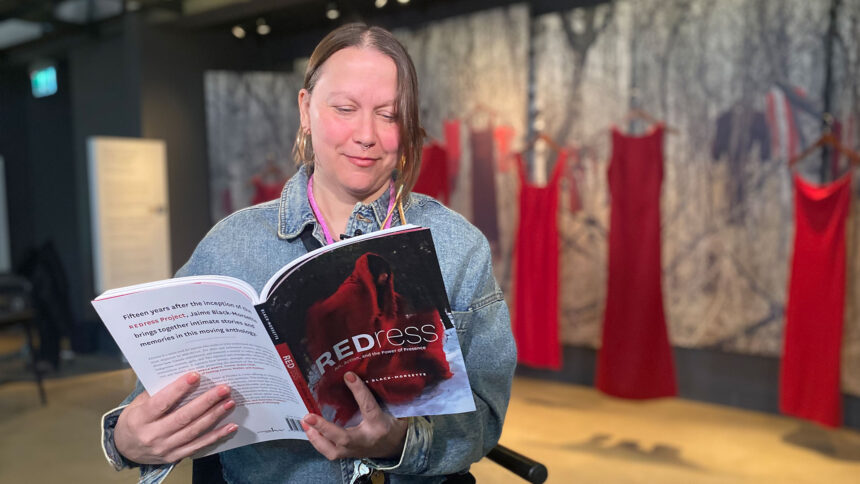For the past 15 years artist Jaime Black-Morsette has been on a journey of sharing the stories of missing and murdered Indigenous women and girls. Earlier this month, she released a book called REDress: Art, Action, and the Power of Presence – a collection of photos, poems, and stories from almost two dozen women on the frontlines of this fight. “I’ve always wanted to put together a book,” said Black-Morsette, “and bring together all the activism and all the amazing women that I have met like all across the country doing this work.” In 2010, the Red River Métis citizen started the Redress Project, collecting hundreds of dresses to help amplify the voices of the families that lost loved ones as they spoke out about the injustices they faced. “Also, around that time there was really racist reporting,” recalls Black-Morsette, adding it was a time before all the systemic issues were outlined so clearly as today, even before the days of the National Inquiry into Indigenous Women and Girls began it’s work in 2017. “The way the media was covering what was going on was very, in the way of victim blaming and really putting women and their families as being responsible somehow for the violence that was happening to them.” She says she remembers seeing families in Winnipeg fighting for justice, often alone. “Just seeing families like using their last 30 bucks to make posters to look for their loved ones, because no one else was supporting them, except for only their close relatives, and so like that systemic indifference,” she said. Black-Morrsette started writing the book in late 2022. At the same time, the Winnipeg police announced a serial killer, Jeremy Skibicki, had preyed on and murdered four vulnerable Indigenous women using homeless shelters in the city. Skibicki, who was sentenced to four life sentences was originally charged with killing only one woman, Rebecca Contois from O-Chi-Chak-Ko-Sipi First Nation, 225 kilometres northwest of Winnipeg. Contois’ partial remains were found in a garbage bin near the serial killer’s home in May 2022. A month later, her torso was recovered in the city owned landfill south of the city. Then in December 2022, the police announced another three victims and that two women from Long Plain First Nation, Morgan Harris and Marcedes Myran, were likely in a private owned landfill north of Winnipeg but a search wasn’t feasible. “It feels really fitting that this book was being written during that time so there’s a record,” Black-Morsette said saying at the time there was no support to retrieve the remains. The inaction sparked a nearly two year political fight to “search the landfill” that was headed up by the families of the slain women and First Nations leaders such as Cathy Merrick, former grand chief of the Assembly of Manitoba Chiefs, who passed away last September. ‘Canada is known as like this benign, benevolent country right and I think it’s really important that we speak out about the realities that are going on here,’ says Black-Morsette. Photo: Tiar Wheatle/APTN. “Cathy is such a wonderful person and she’s since passed away but it felt so fitting that she wrote a forward for this book as she was on the front lines of search the landfill,” she said, adding that Morgan Harris’ oldest daughter, Cambria Harris also contributed to the book. “You know internationally, Canada is known as like this benign, benevolent country right and I think it’s really important that we speak out about the realities that are going on here,” she said. The 140 page book was picked up by Portage & Main Press and Highwater Press and also has an accompanying teacher guide that you can find on their website. Some well known advocates who also contributed to the book include Gladys Radek, a Gitxsan/Wet’suwet’en First Nations woman who started the walk for justice after her niece Tamara Chipman disappeared on the Highway of Tears in 2005; Karine R. Duhamel, who helped with research within the National Inquiry of Missing and Murdered Indigenous Women and Girls and its 231 calls to justice; and Metis artist Christi Belcourt. “I actually learned Christi Belcourt wrote a piece about Maria Campbell’s film called, The Red Dress, I believe that came out in 1980, that’s when I was born,” Black-Morsette said, “I didn’t even know about that film, (until) Christi Belcourt submitted that essay.” She said the film talks about the power and symbolism a red dress carries for Indigenous women. “It is not something that I made up. It’s something that existed and had that power before I came to (use) it,” Black-Morsette said. “It’s so hard to explain, cause like it’s a spiritual thing. So by using that symbol of the red dress we are connecting to so many who came before us and also looking to what the future can be.” Black-Morsette will do a first public reading of the book at the Canadian Museum for Human Rights in Winnipeg on May 4. Continue Reading
REDress project brings together MMIWG activism from across Canada

Leave a Comment










